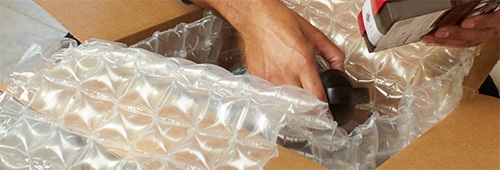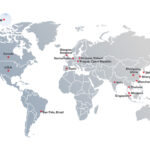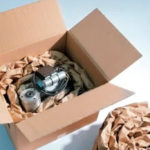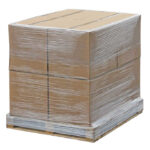Filling the Void to Keep Packages Safe
Did you ever stop to consider that most things that come in the mail or are delivered to your door are either squares or rectangles? No matter the item’s shape, it comes in a box, envelope, or mailer. Consistent shapes make shipping, sorting, hauling, and delivery more efficient but pose a dilemma for packaging. The easiest solution is to go big and fill the gaps or in terms of packaging solutions, use a large box and add void fill. But not all void fill is created equal which is why at Supply Source we’ll make sure you know your options and help you choose the best one.
Void fill, as its name implies, is material packed or, in some cases, pumped into boxes to keep what’s inside from moving around and getting damaged. Void fill can also give an added design flair to a package. It really plays a critical role in product safety and customer satisfaction, which is why choosing the best void fill is a key component of a company’s packaging system.
With our partners at Supply Source, we’re able to offer 16 different types of void fill so whether you’re shipping glasses or basketballs we make sure your products arrive intact. The type of void fill depends on how well you need to cushion your product and protect it from shock, how much padding it needs, and how much it weighs. That basketball can bump around a bit and not be damaged. The same does not hold true for those glasses.
For cost-effectiveness and eco-friendliness, paper is king. It also offers the most variety. Sheets of paper can be crumpled up to fill in gaps, it can be shredded and crinkled to fit even smaller spaces and provide extra cushioning and can be in the form of corrugated paper that is wrapped around items to protect them from dings and scratches. Paper is recyclable and biodegradable making it a popular choice for those wanting a sustainable option.
 Bubble wrap is an old favorite. The entertainment value in recipients being able to pop rows of bubbles may have never been calculated, but it has to add to customer satisfaction. Or at least it did until we all learned the harm that plastic can cause our planet. It’s true, bubble wrap is not eco-friendly, but sometimes it really is the best choice for minimizing product damage because it offers superior shock absorption. There’s a reason rolls of bubble wrap are available through moving companies.
Bubble wrap is an old favorite. The entertainment value in recipients being able to pop rows of bubbles may have never been calculated, but it has to add to customer satisfaction. Or at least it did until we all learned the harm that plastic can cause our planet. It’s true, bubble wrap is not eco-friendly, but sometimes it really is the best choice for minimizing product damage because it offers superior shock absorption. There’s a reason rolls of bubble wrap are available through moving companies.
Similar to bubble wrap are air pillows or air cushions that are basically air-filled bags typically used for shipping larger items, or at least shipping in larger boxes. They are cost-effective and do a great job in shock absorption which is why companies like Amazon regularly rely on air pillows. But like bubble wrap, they are made from plastic which has fallen out of favor with manufacturers and customers alike. However, sustainable air pillows made from paper are starting to make an appearance and may prove to be a winning solution.
Packing peanuts got a bad rap because they were traditionally made from styrofoam which is a big no-no for the environment. Plus those peanuts seemed to cling to everything and quickly turn the excitement of opening a package into a clean-up nightmare for customers. But they are an ideal type of loose-fill packaging that fills up those large empty spaces that surround a product that lacks a uniform size. The solution is the modern packing peanut that is biodegradable and not quite as prone to static cling. They are made from naturally derived starches like wheat and cornstarch and dissolve in water so sustainable, and still as useful and protective as the original styrofoam version. The downside is cost. Turning starch into a packaging product doesn’t come cheap.
 If presentation is nearly as important as protection, custom box inserts are the void-fill solution to choose. Made of paper or cardboard, the inserts are designed to perfectly fit whatever item needs to be shipped and hold it securely in place. The bonus is that the inserts and boxes can be branded for an added touch.
If presentation is nearly as important as protection, custom box inserts are the void-fill solution to choose. Made of paper or cardboard, the inserts are designed to perfectly fit whatever item needs to be shipped and hold it securely in place. The bonus is that the inserts and boxes can be branded for an added touch.
Similar to a custom box insert in how well it protects, is foam in place packaging. Foam is inserted into the box, molds around whatever product is inside, and surrounds it to fill in the empty spaces. The big advantage of foam is that it works no matter what the shape of the item is and it’s easy and quick to use.
For an added layer of protection around your product, foam sheets can be inserted within a box. They are flat sheets that can absorb shock and protect fragile items from scratches. As we’ve mentioned before, foam, or to be exact, styrofoam is falling out of favor because it isn’t sustainable so this void fill is not good for everyone.
There are even more options for void fill but we’ve listed the main types. Obviously deciding which one to choose for your unique product may prove challenging which is where Supply Source comes in. We’re happy to help guide you and we can even do a trial run to ensure whichever void fill you choose, your product will arrive intact. Give us a call to schedule a consultation and see what we can do for you.




Recent Comments